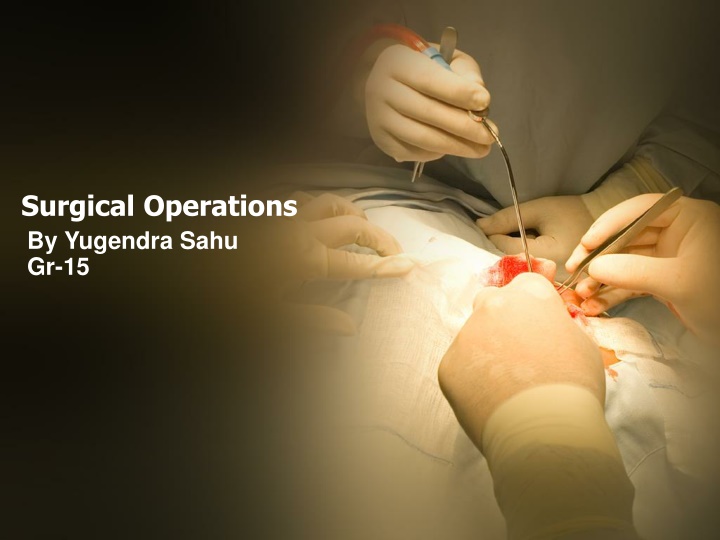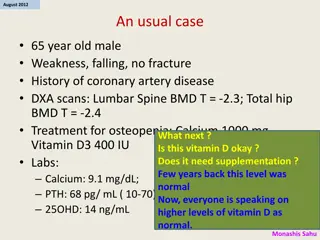
Understanding Surgical Operations and Types of Surgery
Surgical operations involve invasive techniques for diagnostic and therapeutic reasons. Surgery can be categorized by urgency, body system involved, and degree of invasiveness. Types of surgery include amputation, resection, excision, and reconstructive surgery. Explore more about the various aspects of surgical procedures and their significance.
Uploaded on | 1 Views
Download Presentation

Please find below an Image/Link to download the presentation.
The content on the website is provided AS IS for your information and personal use only. It may not be sold, licensed, or shared on other websites without obtaining consent from the author. If you encounter any issues during the download, it is possible that the publisher has removed the file from their server.
You are allowed to download the files provided on this website for personal or commercial use, subject to the condition that they are used lawfully. All files are the property of their respective owners.
The content on the website is provided AS IS for your information and personal use only. It may not be sold, licensed, or shared on other websites without obtaining consent from the author.
E N D
Presentation Transcript
Surgical Operations By Yugendra Sahu Gr-15
Surgery Surgery is an invasive technique with the fundamental principle of physical intervention on organs/organ systems/tissues for diagnostic or therapeutic reasons. As a general rule, a procedure is considered surgical when it involves cutting of a person's tissues or closure of a previously sustained wound. Other procedures that do not necessarily fall under this rubric, such as angioplasty or endoscopy, may be considered surgery if they involve "common" surgical procedure or settings, such as use of a sterile environment, anesthesia, antiseptic conditions, typical surgical instruments, and suturing or stapling. All forms of surgery are considered invasive procedures; so-called "noninvasive surgery" usually refers to an excision that does not penetrate the structure being excised (e.g. laser ablation of the cornea) or to a radiosurgical procedure (e.g. irradiation of a tumor).
Types of surgery Surgical procedures are commonly categorized by urgency, type of procedure, body system involved, the degree of invasiveness, and special instrumentation. Based on timing: Elective surgery is done to correct a non- life-threatening condition, and is carried out at the person's request, subject to the surgeon's and the surgical facility's availability. A semi-elective surgery is one that must be done to avoid permanent disability or death, but can be postponed for a short time. Emergency surgery is surgery which must be done without any delay to prevent death or serious disabilities and/or loss of limbs and functions. Based on purpose: Exploratory surgery is performed to aid or confirm a diagnosis. Therapeutic surgery treats a previously diagnosed condition. Cosmetic surgery is done to subjectively improve the appearance of an otherwise normal structure.
Types of surgery By type of procedure: Amputation involves cutting off a body part, usually a limb or digit; castration is also an example. Resection is the removal of all of an internal organ or body part, or a key part (lung lobe; liver quadrant) of such an organ or body part that has its own name or code designation. A segmental resection can be of a smaller region of an organ such as a hepatic segment or a bronchopulmonary segment. Excision is the cutting out or removal of only part of an organ, tissue, or other body part from the person. Extirpation is the complete excision or surgical destruction of a body part.[3]Replantation involves reattaching a severed body part. Reconstructive surgery involves reconstruction of an injured, mutilated, or deformed part of the body. Transplant surgery is the replacement of an organ or body part by insertion of another from different human (or animal) into the person undergoing surgery. Removing an organ or body part from a live human or animal for use in transplant is also a type of surgery.
Types of surgery By body part: When surgery is performed on one organ system or structure, it may be classed by the organ, organ system or tissue involved. Examples include cardiac surgery (performed on the heart), gastrointestinal surgery (performed within the digestive tract and its accessory organs), and orthopedic surgery (performed on bones or muscles). By degree of invasiveness of surgical procedures: Minimally- invasive surgery involves smaller outer incisions to insert miniaturized instruments within a body cavity or structure, as in laparoscopic surgery or angioplasty. By contrast, an open surgical procedure such as a laparotomy requires a large incision to access the area of interest. By equipment used: Laser surgery involves use of a laser for cutting tissue instead of a scalpel or similar surgical instruments. Microsurgery involves the use of an operating microscope for the surgeon to see small structures. Robotic surgery makes use of a surgical robot, such as the Da Vinci or the ZEUS robotic surgical systems, to control the instrumentation under the direction of the surgeon
Approach of surgery The approach is defined as the technique used to reach the site of the procedure. So basically- how did they enter the body to get to the site that needed to be operated on. There are seven different approaches:-
Approach Definition Method Example Open Cutting through the skin or mucous membrane and any other body layers necessary to expose the site of the procedure Cutting Abdominal hysterectomy Open appendectomy Percutaneous Entry by puncture or minor incision, of instrumentation through the skin or mucus membrane and any other body layers necessary to reach the site of the procedure Percutaneous Endoscopic incision, of instrumentation through the skin or mucus membrane and any other body layers necessary to reach and visualize the site of the procedure Puncture or minor incision Needle biopsy of liver Liposuction Entry by puncture or minor Puncture or minor incision Arthroscopy Laparoscopic cholecystecto my Via natural or artificial opening Entry of instrumentation through a natural or artificial external opening to reach the site of the procedure Direct entry Endotracheal tube insertion Foley catheter placement
Approach Definition Method Example Via natural or artificial opening endoscopic Entry of instrumentation through a natural or artificial external opening to reach and visualize the site of the procedure Direct entry with puncture or minor incision for instrumentation only EGD Colonoscopy Open with percutaneous endoscopic assistance Cutting through the skin or mucus membrane and any other body layers necessary to expose the site of the procedure and entry by puncture Procedures performed directly on the skin or mucus membrane and procedures performed indirectly by the application of external force through the skin or mucus membrane Cutting Laparoscopic -assisted vaginal hysterectomy External No entry into the body Closed fracture reduction Resection of tonsil
Stages of surgical operations/ Perioperative The perioperative period is the time period of a patient's surgical procedure. It commonly includes ward admission, anesthesia, surgery, and recovery. Perioperative may refer to the three phases of surgery: preoperative, intraoperative, and postoperative, though it is a term most often used for the first and third of these only - a term which is often specifically utilized to imply 'around' the time of the surgery. The primary concern of perioperative care is to provide better conditions for patients before operation (sometimes construed as during operation) and after operation
Preoperative Phase The initial phase, called the preoperative phase, begins with the decision to have surgery and ends when the patient is wheeled into surgery. This phase can be extremely brief, such as in the cases of acute trauma, or require a long period of preparation during which time a person may be required to fast, lose weight, undergo preoperative tests, or await the receipt of an organ for transplant. One of the goals of the preoperative phase is to manage the anxiety that may arise, either as a result of an emergency situation or having to wait for inordinately long periods of time. Preoperative anxiety is a common reaction experienced by patients and one that can be relieved with on-going interaction with one or more members of the medical team.1 Prior to intake, that person will usually be the treating doctor and/or surgeon. Once a person is admitted into a hospital, patient care and oversight will typically be coordinated by one or several perioperative nurses.
Intraoperative Phase The second phase, known as the intraoperative phase, involves the surgery itself. It starts when the patient is wheeled into the surgical suite and ends when the patient is wheeled to the post-anesthesia care unit (PACU). During this phase, the patient will be prepped and typically given some form of anesthesia, either general anesthesia (for complete unconsciousness), local anesthesia (to prevent pain while awake), or regional anesthesia (such as with a spinal or epidural block). As the surgery begins, the patient's vital signs (including heart rate, respiration, and blood oxygen) will be closely monitored. In addition to the roles of the surgeon and anesthesiologist, other team members will be responsible for assisting the surgeon, ensuring safety, and preventing infection during the course of the surgery.
Postoperative Phase The final phase, known as the postoperative phase, is the period immediately following surgery. As with the preoperative phase, the period can be brief, lasting a few hours, or require months of rehabilitation and recuperation. Once the patient is awake and ready to leave PACU, the post-anesthesia nurse will typically transfer the responsibility of care back to the perioperative nurse. (In smaller hospitals, the same person may be tasked with both responsibilities.) Postoperative care is mainly focused on monitoring and managing the patient's physiological health and aiding in the post-surgical recovery. This may include ensuring hydration, monitoring urination or bowel movements, assisting with mobility, providing appropriate nutrition, managing pain, and preventing infection.




